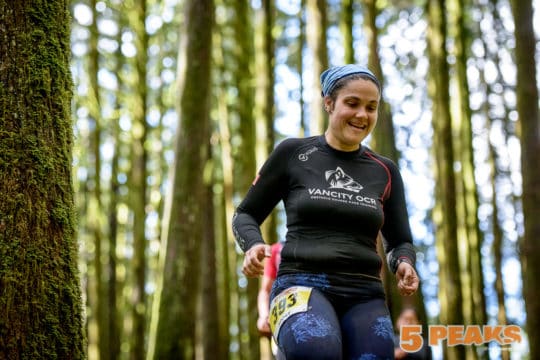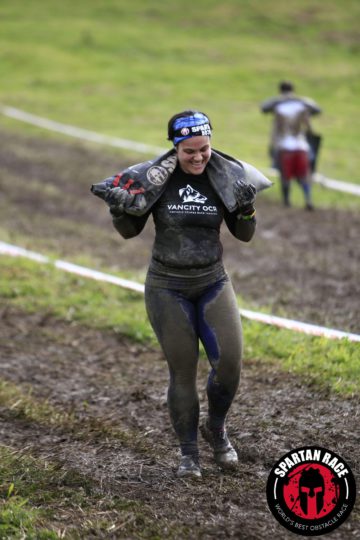
Words by Heather Gomez | Photos by Stephanie Hendy
It’s been an exciting past 10 weeks as I took on the challenge of learning to run, and I’m excited to now consider myself a “runner” after finishing the Ottawa 5K! But if you’re anything like me, you like to regularly change things up and try something new.
At the Vancouver Trail Mix & Mingle in March, I met Stephanie Hendy, a Clinical Exercise Physiologist with Type 1 diabetes. What does she do in her spare time? Obstacle Course Racing (OCR)! Very cool, right?! I took the opportunity to ask her lots of questions about the sport, and I thought it would be great information to pass on to anyone looking for the next adventure to tackle.
Q: What was your sport/fitness background before you started training for OCRs?
A: My sport/fitness background before I started training for OCRs was running, weight training at the gym, and cycling. To get myself into OCRs, I also took up indoor rock climbing, simply to get used to maneuvering vertically/laterally while high up on a structure. I had to give up climbing very recently, only because I wanted to get more OCR-specific with my upper body (e.g. good at monkey bars, hangs, etc.).
Q: What basic fitness skills should someone have if they want to try an OCR?
A: You don’t need to run continuously since OCR is a type of interval training. Being able to run some amount  (especially on uneven surfaces), having some experience with lifting and carrying heavy things, holding one’s own body weight on a structure above (e.g. chin-up bar), being able to do chin-ups is even better (but I’m not there yet myself), comfortable with some amount of hoisting one’s own body (e.g. over a 4 foot vertical wall) and crawling (e.g. under barbed wire with a 2 foot clearance). Really, you just have to not mind the mud. Even better if you love it!
(especially on uneven surfaces), having some experience with lifting and carrying heavy things, holding one’s own body weight on a structure above (e.g. chin-up bar), being able to do chin-ups is even better (but I’m not there yet myself), comfortable with some amount of hoisting one’s own body (e.g. over a 4 foot vertical wall) and crawling (e.g. under barbed wire with a 2 foot clearance). Really, you just have to not mind the mud. Even better if you love it!
Q: What are some of the course options out there? Are some easier/harder than others? How do I pick the right one for me?
A: There are many organizations that offer OCR. I have only done two of them, Rugged Maniac, and Spartan. Rugged Maniac is an excellent entry-level race; other people in my training club would also say that Warrior Dash is a good one to start with. Spartan is really challenging, on the opposite end of the spectrum. Rugged Maniac, you get the option to walk around the obstacles that you feel are unsafe/uncomfortable doing. Spartan, you only get 1 attempt per obstacle, and if you fail it, your punishment is 30 burpees. Tough Mudder is also quite challenging, though I am uncertain if there are obstacle failure punishments. Spartan so far has held the most appeal to me – it has the most amount of obstacles per distance density, averaging 1 obstacle every 400 metres. I am doing 3 Sprints this year, and I plan to do my first Trifecta next year (1 Sprint, 1 Super, 1 Beast). I am also doing 1 Rugged Maniac this year, and am doing the OCR World Championships (shorter courses and allowing multiple attempts of obstacles).
In addition to difficulty as far as the obstacles, one also has to consider the race length.
- Rugged Maniac and the Warrior Dash are both 5K.
- Spartan Sprint is 5-7K, Super is 12-14K, Beast is 21K.
- Tough Mudder is 16-19K, though they now also offer a half which is 8K.
- There are ultra-distance versions of the Spartan and Tough Mudder events as well. For people who enjoy a longer duration challenge and want to do an UltraBeast (42K) or Toughest Mudder (8 hour overnight race), as well as respective Spartan World Championships (special Beast and UltraBeast races) and World’s Toughest Mudder (24 hour race, chosen as either “25, 50, 75, 100 mile” as it is several laps of a 5 mile loop plus penalty laps).
Q: What is the hardest part about running OCRs (physically, mentally, or otherwise)? What is the BEST part?

A: The hardest part is the mental aspect. There will be many times where you will question your sanity and wonder how much farther away the finish line is. The best part is being in tears at an obstacle and having complete strangers help you out (e.g. the 7-foot wall) and then end up finishing the race together. Absolutely, the community is what got me addicted to it. I wasn’t even looking for a community or new thing to join; I was just blown away how I found a group of adventure seeking, adrenaline thriving people who were so down-to-Earth and humble about their accomplishments.
Q: How has your training changed to prepare you for running, as well as obstacles?
A: Before OCR, I was running 3 days a week and going to the gym 2 days a week and climbing 1 day a week. I replaced clim
bing with 1 day a week of obstacle course race training with my club, Vancity OCR. Not much changed because I was already psyching myself up for it. Though I have to say, before Spartan, I was planning to only take my running goal to 10K. However, since finding out about the Trifecta, now I plan to train to run a half-marathon, which is something I previously had no desire to do. This year, I have also been trying to get at least one of my weekly runs out trail running, because that is good prep for OCR, getting used to unstable surfaces and rapidly changing elevation. That being said, I still can’t really go that fast trail running so I keep road running to keep my fitness level up and train myself to run faster.
Q: What is the first piece of advice you would give someone who wants to try an OCR this year?
A: Buy a pair of trail runners.
About Stephanie Hendy
 Stephanie also writes about OCRs on her blog, enablingfitness.ca. Check out her 2016 Year in Review post for a great recap of how she got into OCR, and why she loves it so much.
Stephanie also writes about OCRs on her blog, enablingfitness.ca. Check out her 2016 Year in Review post for a great recap of how she got into OCR, and why she loves it so much.




